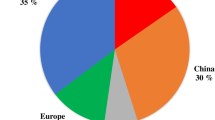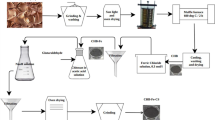Abstract
The use of bacterial cell or biocatalyst for industrial synthetic chemistry is on the way of significant growth since the biocatalyst requires low energy input compared to the chemical synthesis and can be considered as a green technology. However, majority of natural bacterial cell surface is hydrophilic which allows poor access to the hydrophobic substrate or product. In this study, Escherichia coli (E. coli) as a representative of hydrophilic bacterial cells were accumulated at the oil–water interface after association with chitosan at a concentration range of 0.75–750 mg/L. After association with negatively charged E coli having a ζ potential of −19.9 mV, a neutralization of positively charged chitosan occurred as evidenced by an increase in the ζ potential value of the mixtures with increasing chitosan concentration up to +3.5 mV at 750 mg/L chitosan. Both emulsification index and droplet size analysis revealed that chitosan-E. coli system is an excellent emulsion stabilizer to date because the threshold concentration was as low as 7.5 mg/L or 0.00075 % w/v. A dramatic increase in the surface hydrophobicity of the E. coli as evidenced by an increase in contact angle from 19 to 88° with increasing chitosan concentration from 0 to 750 mg/L, respectively, resulted in an increase in the stability of oil-in-water emulsions stabilized by chitosan-E. coli system. The emulsion was highly stable even the emulsification was performed under 20 % salt condition, or temperature ranged between 20 and 50 °C. Emulsification was failed when the oil volume fraction was higher than 0.5, indicating that no phase inversion occurred. The basic investigation presented in this study is a crucial platform for its application in biocatalyst industry and bioremediation of oil spill.






Similar content being viewed by others
References
Ramsden W (1904) Separation of solids in the surface-layers of solution and suspension. Proc R Soc 72:156–164
Pickering SU (1907) Emulsions. J Chem Soc 91:2001–2021
Wongkongkatep P, Manopwisedjaroen K, Tiposoth P, Archakunakorn S, Pongtharangkul T, Suphantharika M, Honda K, Hamachi I, Wongkongkatep J (2012) Bacteria interface pickering emulsions stabilized by self-assembled bacteria-chitosan network. Langmuir 28:5729–5736
Saigal T, Dong H, Matyjaszewski K, Tilton RD (2010) Pickering emulsions stabilized by nanoparticles with thermally responsive grafted polymer brushes. Langmuir 26:15200–15209
Saigal T, Yoshikawa A, Kloss D, Kato M, Golas PL, Matyjaszewski K, Tilton RD (2013) Sable emulsions with thermally responsive microstructure and rheology using poly(ethylene oxide) star polymers as emulsifiers. J Colloid Interface Sci 394:284–292
Schmid A, Dordick JS, Hauer B, Kiener A, Wubbolts M, Witholt B (2001) Industrial biocatalysis today and tomorrow. Nature 409:258–268
Wangrangsimagul N, Klinsakul K, Vangnai AS, Wongkongkatep J, Inprakhon P, Honda K, Ohtake H, Kato J, Pongtharangkul T (2012) Bioproduction of vanillin using an organic solvent-tolerant Brevibacillus agri 13. Appl Microbiol Biotechnol 93:555–563
Siriphongphaew A, Pisnupong P, Wongkongkatep J, Inprakhon P, Vangnai AS, Honda K, Ohtake H, Kato J, Ogawa J, Shimizu S, Urlacher BV, Schmid DR, Pongtharangkul T (2012) Development of a whole-cell biocatalyst co-expressing P450 monooxygenase and glucose dehydrogenase for synthesis of epoxyhexane. Appl Microbiol Biotechnol 95:357–367
Marques MPC, de Carvalho CCCR, Cabral JMS, Fernandes P (2010) Scaling-up of complex whole cell bioconversion in conventional and non-conventional media. Biotechnol Bioeng 106:619–626
Sardessai YN, Bhosle S (2004) Industrial potential of organic solvent tolerant bacteria. Biotechnol Prog 20:655–660
Cornelissen S, Julsing MK, Volmer J, Riechert O, Schmid A, Buehler B (2013) Whole-cell-based CYP153A6-catalyzed (s)-limonene hydroxylation efficiency depends on host background and profits from monoterpene uptake via AlkL. Biotechnol Bioeng 110:1282–1292
McIver AM, Garilipati SVBJ, Bankole KS, Gyamerah M, Peeples TL (2008) Microbial oxidation of naphathelene to cis-1,2 naphthalene dihydrodiol using naphthalene dioxygenase in biphasic media. Biotechnol Prog 24:593–598
Mahendra S, Grostern A, Alvarez-Cohen A (2013) The impact of chlorinated solvent co-contaminants on the biodegradation kinetics of 1,4-dioxane. Chemosphere 91:88–92
Rinaudo M (2006) Chitin and chitosan: properties and applications. Prog Polm Sci 31:603–632
Pimpha N, Rattanonchai U, Surassmo S, Opanasopit P, Rattanarungchai C, Sunintaboon P (2008) Preparation of PMMA/acid-modified chitosan core-shell nanoparticles and their potential as gene carriers. Colloid Polym Sci 286:907–916
An J, Zhang H, Zhang J, Zhao Y, Yuan X (2009) Preparation and antibacterial activity of electrospun chitosan/poly(ethylene oxide) membranes containing silver nanoparticles. Colloid Polym Sci 287:1425–1434
Yang J, Cai J, Hu Y, Li D, Du Y (2012) Preparation, characterization and antimicrobial activity of 6-amino-6-deoxychitosan. Carbohyd Polym 87:202–209
Li X, Feng X, Yang S, Fu G, Wang T, Su Z (2010) Chitosan kills Escherichia coli through damage to be of cell membrane mechanism. Carbohyd Polym 79:493–499
Hollappa J, Hjlmarsottir M, Masson M, Runarsson O, Asplund T, Soininen P et al (2006) Antimicrobial activity of chitosan N-betainates. Carbohyd Polym 65:114–118
Binks BP, Dyab AKF, Fletcher PDI (2007) Contact angles in relation to emulsions stabilized solely by silica nanoparticles including systems containing room temperature ionic liquids. Phys Chem Chem Phys 9:6391–6397
Dickinson E (2010) Food emulsions and foams: stabilization by particles. Curr Opin Colloid Interface Sci 15:40–49
Binks BP (2002) Particles as surfactants-similarities and differences. Curr Opin Colloid Interface Sci 7:21–41
Del Blanco LF, Rodringuez MS, Schulz PC, Agullo E (1999) Influence of the deacetylation degree on chitosan emulsification properties. Colloid Polym Sci 277:1087–1092
Ashby NP, Binks BP (2000) Pickering emulsions stabilized by laponite clay particles. Phys Chem Chem Phys 2:5640–5646
Beattie JK, Djerdjev AM (2004) The pristine oil/water interface: surfactant-free hydroxide charged emulsions. Angew Chem Int Ed 43:3568–3571
Franks GV, Djerdjev AM, Beattie JK (2005) Absence of specific cation or anion effects at low salt concentration on the charge at the oil/water interface. Langmuir 21:8670–8674
McClement DJ (1999) Food emulsions: principles, practice, and techniques. CRC Press, Florida
Tzoumaki MV, Moschakis T, Kiosseoglou V, Biliaderis CG (2011) Oil-in-water emulsions stabilized by chitin nanocrystal particles. Food Hydrocolloid 25:1521–1529
Tsuchido T, Katsui N, Takeuchi A, Takano M, SHibasaki I (1985) Destruction of the outer membrane permeability barrier of Escherichia coli by heat treatment. Appl Environ Microbiol 50:298–303
Binks BP, Whithy CP (2004) Silica particle-stabilized emulsions of silicone oil and water: aspects of emulsification. Langmuir 20:1130–1137
Huesken LE, Dalm MCF, Tramper J, Wery J, de Bont JAM, Beeftink R (2001) Integrated bioproduction and extraction of 3-methylcatechol. J Biotechnology 88:11–19
Rojas A, Duque E, Schmid A, Hurtado A, Ramos JL, Segura A (2004) Biotransformation in double-phase systems: physiological responses of Pseudomonas putida DOT-T1E to a double phase made of aliphatic alcohols and biosynthesis of substituted catechols. Appl Environ Microbiol 70:3637–3643
Ye X, Honda K, Sakai T, Okano K, Omasa T, Hirota R, Kuroda A, Ohtake H (2012) Synthetic metabolic engineering-a novel, simple technology for designing a chimeric metabolic pathway. Microb Cell Fact 11:120
Acknowledgments
Thailand Research Fund and Mahidol University (Grant No. RSA5580001) were acknowledged for their financial support.
Author information
Authors and Affiliations
Corresponding author
Rights and permissions
About this article
Cite this article
Archakunakorn, S., Charoenrat, N., Khamsakhon, S. et al. Emulsification efficiency of adsorbed chitosan for bacterial cells accumulation at the oil–water interface. Bioprocess Biosyst Eng 38, 701–709 (2015). https://doi.org/10.1007/s00449-014-1310-6
Received:
Accepted:
Published:
Issue Date:
DOI: https://doi.org/10.1007/s00449-014-1310-6




